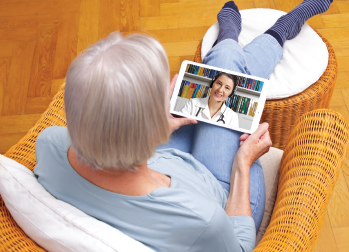
© Agenturfotografin / shutterstock.com
In early March 2020, the Washington University School of Medicine in St. Louis embarked on a new experiment in patient care: It began beta testing a telemedicine system. Before then, no virtual medical visits were being conducted there, and the change was expected to be rolled out relatively slowly.
Explore This Issue
November 2020But instead, in what has become a familiar experience throughout society during the COVID-19 pandemic, that change came suddenly. Physicians found they could either see patients virtually, or barely see any at all. Payers began reimbursing for virtual visits at the same rate as in-person visits. Like it or not, the era of virtual medicine had arrived.
“There’s nothing like a crisis to force you to innovate,” said Joseph P. Bradley, MD, assistant professor of otolaryngology–head and neck surgery at Washington University.
Telehealth Expansion
Innovation under pressure might not sound like a recipe for creating patient contentment with virtual visits. But Dr. Bradley said patients have reported high satisfaction, as they’ve been able to avoid many of the headaches of traditional visits. “It’s the driving to and from appointments,” he said. “It’s the finding a place to park. If I were on the main medical campus for Washington U., they’d have to pay for parking.”
Otolaryngologists around the country report a similar phenomenon. Although many departments had barely dipped a toe in the virtual-visit pool before they were forced to dive in, patients have been almost uniformly happy. Physicians say this has perhaps set the groundwork for a long-lasting change to a much higher percentage of virtual visits, with many types of visits surprisingly feasible without the patient sitting physically in front of a healthcare provider.
A study recently published online in JAMA Otolaryngology found that otolaryngologists provided just 2,127 telemedicine services to Medicare beneficiaries from 2010 to 2018, receiving $88,574 in payment for those services. The number of services per physician in otolaryngology had an annual growth rate of 11%. By comparison, dermatologists provided 3,815 telemedicine service sessions to their patients in the same time period, and had an annual growth rate of 13%.
I thought patients would be really disappointed—I can’t examine them, and I can’t have an intimate connection with them in person. But surprisingly, the emotional connection that I felt with the patient, and vice-versa, was very strong. —Courtney Voelker, MD, PhD
Other specialties have found that telemedicine is a satisfying option for patients as well. A recent study conducted by the University of Michigan in collaboration with the American Academy of Sleep Medicine (AASM) compared the effectiveness of cognitive-behavioral therapy for insomnia through the AASM’s telemedicine platform to in-person therapy for 65 randomized patients. The patients reported no differences between the telemedicine and in-person visits in terms of overall satisfaction with their treatment or their therapist’s warmth and skills (Sleep, published online July 13, 2020).
Patrick Barth, MD, medical director of specialty care at Nemours Children’s Health System and a pediatric otolaryngologist in Wilmington, Del., said that before March, there were many providers who were hesitant to offer telemedicine because they were worried that the logistics would prevent them from providing the same level of care. A few early virtual visit “champions” offered some visits by video, he noted, mostly limited to follow-ups to review sleep studies or X-ray results, or for post-op visits.
In February 2020, Nemours had 1,100 visits by telehealth, Dr. Barth said. By March, COVID-19 shutdowns blanketed the country. And in April, the number of telehealth visits at Nemours had risen to 28,000. Before the pandemic, only about 150 to 200 Nemours providers were offering any visits virtually, but by June, nearly 900 providers had done so. In brief surveys conducted after visits, Nemours patients gave an average of 4.9 out of 5 stars to the experience with the provider, and an average of 4.8 to the platform experience.
“All the pediatric ENT providers were providing telehealth once COVID hit,” Dr. Barth said. “We went from just follow-ups to new patients and seeing the whole breadth of diagnoses in that fashion.”
Courtney Voelker, MD, PhD, chief of otology, neurotology, and skull base surgery at the Keck School of Medicine at the University of Southern California in Los Angeles, led a project examining 500 patient encounters before and after the onset of COVID-19, in which patients and physicians were asked specific questions meant to assess the quality of care, the communication of important information, and whether they thought the medical problem had been handled in a satisfactory way. The preliminary analysis of the data has been encouraging, she said.